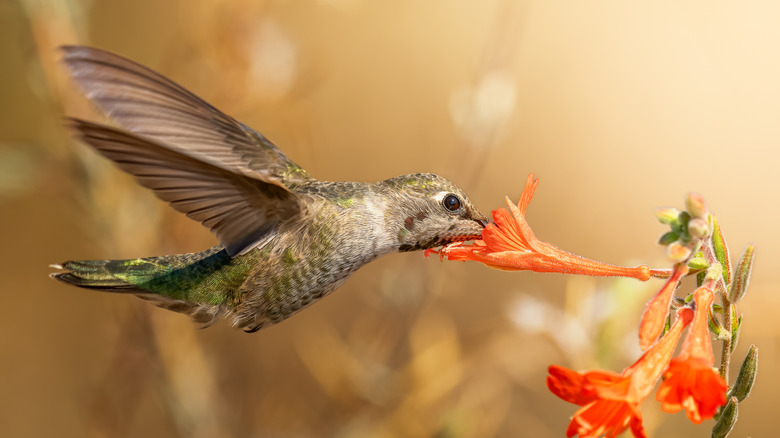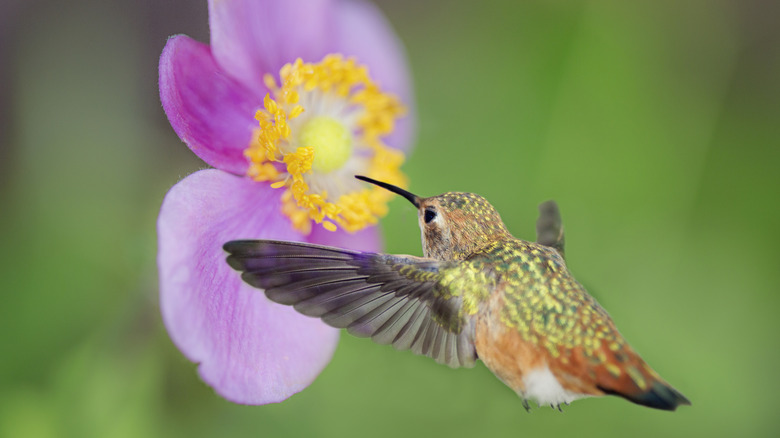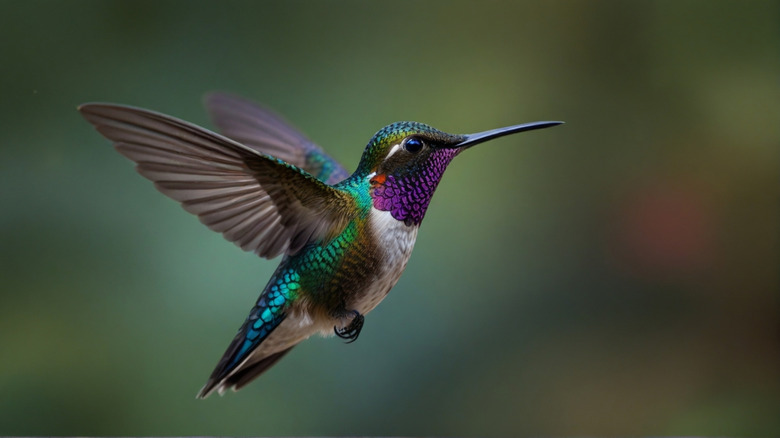Hummingbirds Are The Only Bird Species That Can Do This Trick
Birds are all around us, and as such, we don't necessarily think about how incredible they are. These are creatures that descended from therapods, a group of two-legged dinosaurs to which the Tyrannosaurus rex also belonged. Modern birds are obviously not quite as imposing as a T. rex, but their adaptations are perhaps just as impressive in their own way.
Wings, for example, are an incredible bird adaptation which came towards the end of birds' evolution away from their dinosaur ancestors. After feathers and wishbones came wings, which when coupled with birds becoming much smaller as they evolved, allowed them to take flight and stay airborne. It's incredible to think of birds as tiny flying dinosaurs, but in a sense that's what they are.
Despite all these astonishing features of birds, there is one thing that they can't do: Birds cannot fly backwards. Or, more specifically, all but one family of birds cannot fly backwards. Hummingbirds are the remarkable exception to this rule, and have evolved a number of physical features which allow them to fly in ways that no other bird can. Here's why hummingbirds are the only birds that can fly backwards.
Birds can only fly forwards due to their muscle structure
In order to take flight and stay airborne, birds need wings, feathers, a streamlined body, and a lightweight frame. These are all adaptations that emerged over millions of years to allow birds to fly, but as important as these other elements are, the whole process of flight really does begin with the wings.
In order to fly, birds have to flap their wings, which they do by pulling the wing down using strong muscles in their chests, then bringing them back up using the smaller muscles in the wing. This motion causes air to flow over the wings and pushes the bird upwards while the curved shape of the wings creates for low pressure above and high pressure below, keeping them airborne.
Due to the fact birds have such strong chest muscles and comparatively weak wing muscles, they're unable to push enough air forward to propel them backwards. Instead, the structure of birds' wings and the muscles involved mean air is always pushed backwards, propelling the birds forward. With hummingbirds, however, that's not the case.
Hummingbird flight is unlike any other bird
Hummingbirds are unique birds for many reasons. Not only do hummingbirds help pollination by visiting hundreds of flowers per day, they can also beat their wings up to 60 to 80 times per second, which is truly incredible when you think about it. Depending on the species, that works out to between 720 to 5,400 times per minute while hovering. Hummingbirds can also fly at speeds of up to 60 mph while mating. In order to maintain such activity, hummingbirds not only need frequent rest, but their bodies are composed in a different way to other birds. Whereas most birds' bodyweights are made up of around 15% muscle, hummingbirds' bodyweight is around 25–30% muscle.
This is part of the explanation for how hummingbirds are able to fly backwards. Alongside these more developed flight muscles, the small birds also have a ball-and-socket joint in their shoulder (rare among birds) and another at the wrist, which allows their wings to move in all directions. Not only does this mean the birds can move their wings in a figure-eight movement, allowing them to hover, it also means they can push air forward, allowing them to fly backwards. Through a combination of their unique muscles, rotating wrist joints, and wing movement, then, hummingbirds are the only birds in existence that can fly backwards.


